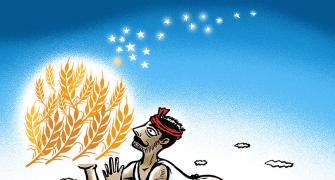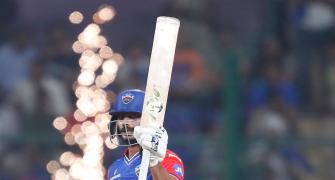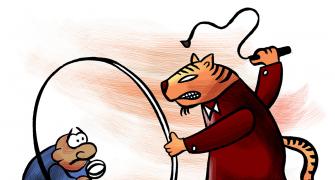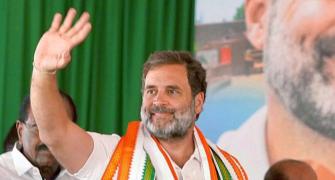Reviving even a storied brand isn't easy once consumers have a negative perception of it. Just ask Ford or Gap, which lost 19 per cent and 15 per cent of their brand value, respectively, in this year's BusinessWeek/Interbrand annual ranking of the 100 Best Global Brands. Even such perennial winners as Coca-Cola (No. 1) can have trouble boosting their brand.
The beverage giant claimed the top spot for the seventh year in a row mostly because it is big and everywhere, but it failed to further burnish its reputation because its move into healthier drinks and snacks has yet to resonate.
Still, it's possible to stage a brand comeback. Several such stories emerged in this year's ranking, which is compiled in partnership with leading global brand consultant Interbrand Corp. and calculates brand value by using publicly available data, projected profits, and such variables as market leadership.
While it's tempting for a challenged brand to emulate the likes of Google (No. 20), Apple (No. 33), or Starbucks (No. 88), doing so can seem audacious at best, delusional at worst. A potentially more useful exercise: examining brands that have stumbled but recovered. "Benchmark brands should be studied, but solutions can seem a lot more accessible when you can see how someone fell and picked themselves up," says Interbrand CEO Jez Frampton.
Take Nokia Corp. Given its No. 5 ranking, it may seem crazy to consider the Finnish giant a comeback story. But it is one, as evidenced by a 12 per cent jump in brand value, which extends a rankings winning streak after faltering in 2004.
Nokia realised its focus on making cheap handsets for the developing world was hurting it in the US and Europe, where consumers wanted phones that played video and surfed the Web. Nokia released high-end phones aimed at both the consumer and business user and is showing strength in emerging and mature markets alike.
Here are five more comeback stories. They detail Nintendo Co.'s successful campaign for new customers; what Audi is doing to catch up with BMW; how Hewlett-Packard persuaded consumers that it's hip; Burberry's strategy to escape the taint of ubiquity; and Citibank's moves to reposition itself as a (very big) local bank.
Nintendo
Daring to go after a new crowd
Nintendo's marketers had apretty good idea that the new Wii player would be a game changer, thanks to a newfangled wireless controller that is wielded like a light saber. And yet they didn't slap the Nintendo name on the gadget. Why? Because the company wanted to make it clear that the Wii was not just for gamers but was also a home entertainment system for all. "I'm not concerned about the spread of the Wii brand," says Nintendo President Satoru Iwata, "because I think the brand name of Nintendo is expanding with it."
To get across the message, Nintendo paired its advertising with a savvy PR campaign. The company identified influential bloggers who were either moms or members of large, multigenerational families. Ahead of the November, 2006, launch, Nintendo hosted parties for the individual families or for groups of the moms' friends, showing them how easy the Wii was for anyone to use.
"You'd have grandparents picking up the controller and saying: Wow, I can actually do this,'" says Stephen Jones, executive vice-president at GolinHarris, which ran the Wii's PR campaign. "Grandparents could see this as a new way to play with their grandkids." That, along with mentions ranging from TV news stories about Wiis in nursing homes to an episode of South Park featuring a Wii-coveting Cartman, spurred word-of-mouth and buzz in all age groups.
Unless you've been living under a rock, you know that Nintendo's Wii strategy has shaken the $30 billion gaming industry. The innovative player has sold well (9.3 million units and counting) and set Nintendo apart from its rivals. As a result, the company surged seven places, to No. 44, in this year's ranking and boosted its brand value by 18 per cent. Revenues in the most recent quarter more than doubled to $2.83 billion, and Nintendo raised its annual profit forecast 42 per cent, to $2.04 billion.
Audi
Hatching a plan and sticking to it
The Audi brand has long suffered in comparison with its more prestigious German rivals. If Wall Streeters drove BMWs and Mercedes-Benzes, Audi was embraced by suburban lawyers and the like. Now that's changing. Even in its home market, where people can be excessively snooty about their wheels, Volkswagen's premium brand has been ranking high in consumer surveys, with some of its models even placing ahead of BMW and Mercedes.
- Slide show: Best global brands 2007 - biggest losers
- Slide Show: Best global brands 2007 -- brands on the verge
Ralph Weyler, the management board member in charge of global sales and marketing, credits a plan put in place 20 years ago to make "bold technological and design statements."
Audi gradually gained respect throughout the 1990s and has had a slew of design hits of late, among them the R8 street racer, the Q7 SUV, and the A5 coupe. Models like these are transforming Audi from a mass-market carmaker to a premium one and help explain why the brand is on a tear.
"An organization's long-term commitment to a sound, consistent plan can protect a company from a lot of mistakes that hurt brand value," says Interbrand's Frampton.
At the same time, Audi has been listening to consumers. A survey of 65,000 people worldwide conducted since 2001 shows that Audi now trails BMW and Mercedes by only a narrow margin in Europe and Asia. In the U.S., the automaker is spending heavily to polish its image.
A long-running campaign that Americans found vague, themed "Never Follow," has given way to "Truth in Engineering." Global sales are up 9.8 per cent overall in the first half of this year. And Audi has moved up six spots in the rankings, to No. 68, and increased its brand value 17 per cent.
Hewlett-Packard
Challenging the status quo
Regaining your position as the world's biggest seller of personal computers is impressive, especially when just two years earlier critics were clamoring for you to get out of the PC business altogether.
Credit goes to CEO Mark Hurd, who told his lieutenants that Hewlett-Packard Co. had to stop building and marketing the PC as if it were a commodity. Designing PCs that consumers actually want was, of course, the starting point. Besides making them more attractive, HP included such features as the ability to check e-mail and appointments without wasting precious minutes booting up.
The marketing team then went about pitching HPPCs as a personal reflection of consumers' desires and needs. Hence the slogan: "The computer is personal again." Last summer the company rolled out ads showing hip-hop mogul Shawn "Jay-Z" Carter mixing music and planning tours using an HPPC. Rising sales and market share show that customers increasingly see HP's products, particularly its laptops, as cooler, hipper, and just plain better than Dell Inc.'s.
Hurd also has focused on HP's sprawling global operations, using the same marketing strategy it is employing in the U.S. to ramp up consumer sales in emerging markets. In Russia, for example, HP has recently started mass advertising and selling PCs through retailers.
The comeback is reflected in the rankings. HP has gained 9 per cent this year in brand value and 18 per cent since 2005. That follows a 10 per cent slide from 2004 to 2005. What's more, Hurd managed to keep his focus on the business even as his board broke into open warfare following a spying scandal that dominated the business news for several weeks last year.
Burberry
Mining the past to seize the future
When British soccer fans began donning Burberry hats en masse about five years ago, it became clear that the fashion icon had forfeited some of its prestige. Ditto when a British soap opera star appeared in the tabloids with her new baby swaddled head to toe in the iconic plaid pattern.
When holiday sales tanked in 2004, Burberry knew that it was on its way to becoming overexposed. It was time to retrench. Since then, Burberry has walked a careful line: moving beyond plaid without disrespecting its fashion history.
In 2006, to mark its 150th anniversary, Burberry mined its design archives and launched the Icons collection, comprising luxury handbags, shoes, boots, trench coats, and small leather goods. The collection combined the classic Burberry look with such flourishes as quilted linings. Customers applauded. "It's a blend of old and new, functional yet fashionable," says Chief Financial Officer Stacey Cartright.
Meanwhile, Burberry began to do away with lower-end products such as stadium hats and scarves that retailed for less than $50. Originally these were aimed at winning younger shoppers who would trade up later on. But Burberry decided they undermined the brand and were too easy for counterfeiters to copy.
So far, the new direction is paying off. Burberry shares are up almost 40 per cent in the past year alone, after taking four years to double from the July, 2002, initial public offering. And the company moved up three places in the rankings, to No. 95, and watched its brand value jump 16 per cent. With its brand on the mend, Burberry is branching out into jewelry, such as bracelets that employ leather to mirror the brand's aesthetic, but skip the plaid.
Citibank
Staying big but going local
Wall Street and some institutional investors continue to push for a breakup of Citi, which they say should choose between being an investment bank or a consumer lender. And the stock is still languishing. But while the institutional banking side of the house has suffered setbacks under Citigroup CEO Charles "Chuck" Prince, the retail and consumer side of the business is growing and was the primary driver of global brand value in 2006.
Indeed, Citi posted a 9 per cent gain and held on to its position as the No. 11 global brand, thanks to a concerted effort to boost its retail presence.
Citi has long been a familiar brand, but it also shorted customers worldwide on retail services. In the U.S. and abroad, it badly trailed such rivals as Bank of America and even regional banks in terms of branch and ATM locations. What's more, its fees tended to be higher than competitors'.
As it opens thousands of branches worldwide, Citi has been focusing on looking more local. It's a strategy of selling itself as a "neighborhood bank" but one with the resources of the global giant it is, says Ajay Banga, chairman and CEO of the bank's Global Consumer Group.
Citi is going to its customers rather than the other way around. In the US it put ATMs in more than 5,000 7-Eleven stores. In India, it has been opening branches on corporate campuses. In Singapore, its branches and ATMs are appearing in subway stations. Citi's new global ad campaign, "Let's Get It Done," replacing "Live Richly," reflects its focus on consumers' practical banking needs.
Although Citi is widely viewed as a US company, Banga says the goal is to derive 60 per cent of its consumer business outside the US within a few years, from around 45 per cent today. To win over South Indians, it made low-cost loans available to fisherwomen.
In Turkey, it dialed down service fees and interest rates on credit cards, so it was no longer the priciest bank despite its premium-brand position. "We learned not to use your brand to stay at the top end of pricing, because it reduces trust," says Banga.







